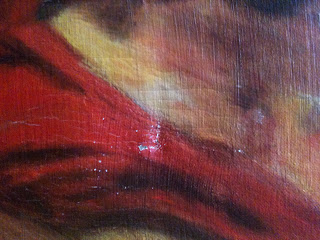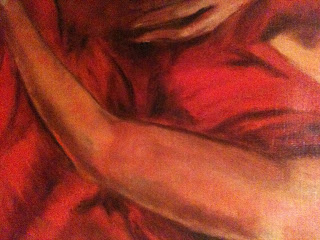Sarah Schrift
Summer 2007
Forth Grade Level
Huichol inspired yarn paintings
Objectives and Goals:
· To learn about the Huichol people of North Central Mexico
· To appreciate art from other cultures
· To understand how symbols are used in culture and in art
· To learn the technique of Huichol yarn painting and how we have adapted it to fit classroom concerns/needs
· To establish our own personal subject matter of something you love and/or believe in
Anticipatory Set (approximate time): An introduction to the Huichol culture and their yarn paintings will take about 5 minutes.
The word "Huichol" is pronounced Wettchol. The Huichol are descendents of the Aztec, the Huichol number about 18,000, most of which live in the sierra of Jalisco and Nayarit. (This will be illustrated by a map.) Having withstood the Spanish Invasion, they are still striving to keep their culture alive and viable, despite the ever increasing physical and cultural encroachment of their Mexican neighbors. Their colorful beadwork and yarn work reflects a reverent and symbiotic relationship with nature.”
From the time they are children, they learn how to communicate with the spirit world through symbols and rituals. For the Huichol, yarn painting is much more than mere aesthetic expression. The topics of these yarn paintings reflect Huichol culture and its shamanic traditions. (Definition of Shaman: a priest or priestess who uses magic for the purpose of curing the sick, divining the hidden and controlling events.) Like icons (Definition of icon: A person or thing regarded as a representative symbol of something) they are documents of ancient wisdom.
*(Traditionally, the Huichol use beeswax to glue the yarn onto their surfaces but in this case, white glue will be used as it is safer and doesn’t require heat. )
Direct Instruction (approximate time): 2.5 minutes
The teacher will demonstrate how to start the project by quickly sketching on the canvas board to illustrate the design plan. The teacher will explain the choice of subject matter and how it relates to something that is loved or believed in and the reasons behind specific color choices. The teacher will then proceed to dip a length of yarn at a time (the yarn must be coated entirely with glue) into the glue and place it directly onto the board. The yarn will follow the sketched design in alternating colors. The process will be repeated. The teacher will warn the students to be careful not to move the glue covered yarn that has already been placed on the canvas. The wet yarn can be easily disturbed but will dry in place after a few hours. Pieces of glue covered yarn will be placed all over the canvas until it is completely covered .
Guided Practice (approximate time): Guidance at the beginning of the project will take about 2.5 minutes.
The students will then begin their projects as the teacher walks around the classroom to help them as it is needed. Most concerns will be over the subject of their design and the handling of the medium.
Independent Practice (approximate time): 18-20 minutes.
Students will complete their projects and will be urged to cover all of the white of the canvas. Surprisingly, as the yarn is thick and the students have just a small area to cover, most will finish in 20 minutes or less.
Required Materials and Equipment:
· 8” x 10” prepared canvas boards
· A gallon of white Elmer’s Glue
· Paper plates or plastic bowls for distributing the glue
· Multi-colored balls of thick yarn
· Scissors for all of the students
· Newspaper to cover the tables
· Pencils
· Erasers
· Pencil sharpeners
· A drying table (the canvas boards will be placed here so they can dry over night)
· A nearby sink with soap for gluey hands
Assessment and Follow-Up: Will be discussed as the students are finishing up with their projects. This will take 1-2 minutes.
· How have we used symbols in our yarn paintings to express the things that we love or believe in?
· How have we used colors to convey the meaning behind these symbols?






























